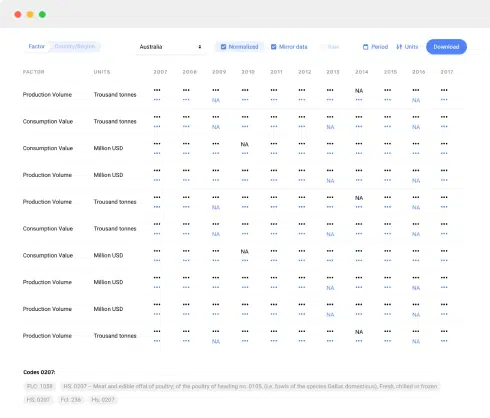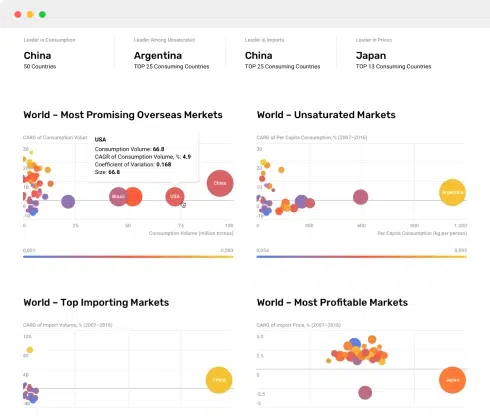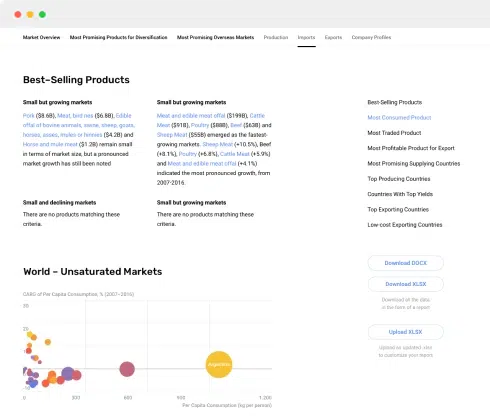
Latin America and the Caribbean - Glutamic Acid and Its Salts - Market Analysis, Forecast, Size, Trends and Insights
Get instant access to more than 2 million reports, dashboards, and datasets on the IndexBox Platform.
View PricingLatin America and the Caribbean: Glutamic Acid Market 2025
Glutamic Acid Market Size in Latin America and the Caribbean
The Latin American glutamic acid market expanded rapidly to $X in 2022, rising by 8.8% against the previous year. Overall, consumption showed a relatively flat trend pattern. Over the period under review, the market hit record highs in 2022 and is likely to see steady growth in the immediate term.
Glutamic Acid Production in Latin America and the Caribbean
In value terms, glutamic acid production declined slightly to $X in 2022 estimated in export price. Over the period under review, production, however, showed a perceptible descent. The most prominent rate of growth was recorded in 2021 with an increase of 4.6%. Over the period under review, production hit record highs at $X in 2012; however, from 2013 to 2022, production stood at a somewhat lower figure.
Glutamic Acid Exports
Exports in Latin America and the Caribbean
After two years of decline, shipments abroad of glutamic acid and its salts increased by 1.5% to X tons in 2022. Over the period under review, exports continue to indicate a relatively flat trend pattern. The pace of growth appeared the most rapid in 2015 with an increase of 14%. The volume of export peaked at X tons in 2019; however, from 2020 to 2022, the exports failed to regain momentum.
In value terms, glutamic acid exports skyrocketed to $X in 2022. Overall, exports, however, saw a relatively flat trend pattern. The level of export peaked at $X in 2012; however, from 2013 to 2022, the exports remained at a lower figure.
Exports by Country
Brazil prevails in exports structure, reaching X tons, which was near 97% of total exports in 2022. Peru (X tons) followed a long way behind the leaders.
Brazil experienced a relatively flat trend pattern with regard to volume of exports of glutamic acid and its salts. Peru (-6.2%) illustrated a downward trend over the same period. Peru (-1.5 p.p.) significantly weakened its position in terms of the total exports, while the shares of the other countries remained relatively stable throughout the analyzed period.
In value terms, Brazil ($X) remains the largest glutamic acid supplier in Latin America and the Caribbean, comprising 97% of total exports. The second position in the ranking was held by Peru ($X), with a 1.7% share of total exports.
From 2012 to 2022, the average annual growth rate of value in Brazil was relatively modest.
Export Prices by Country
In 2022, the export price in Latin America and the Caribbean amounted to $X per ton, with an increase of 49% against the previous year. Over the period under review, the export price, however, continues to indicate a relatively flat trend pattern. Over the period under review, the export prices hit record highs at $X per ton in 2012; however, from 2013 to 2022, the export prices failed to regain momentum.
Average prices varied noticeably amongst the major exporting countries. In 2022, amid the top suppliers, the country with the highest price was Peru ($X per ton), while Brazil amounted to $X per ton.
From 2012 to 2022, the most notable rate of growth in terms of prices was attained by Peru (+0.5%).
Glutamic Acid Imports
Imports in Latin America and the Caribbean
Glutamic acid imports amounted to X tons in 2022, surging by 2.6% compared with the previous year. Total imports indicated a notable expansion from 2012 to 2022: its volume increased at an average annual rate of +4.1% over the last decade. The trend pattern, however, indicated some noticeable fluctuations being recorded throughout the analyzed period. Based on 2022 figures, imports increased by +51.5% against 2016 indices. The pace of growth was the most pronounced in 2019 with an increase of 23%. The volume of import peaked in 2022 and is expected to retain growth in years to come.
In value terms, glutamic acid imports soared to $X in 2022. Total imports indicated a moderate expansion from 2012 to 2022: its value increased at an average annual rate of +3.8% over the last decade. The trend pattern, however, indicated some noticeable fluctuations being recorded throughout the analyzed period. Based on 2022 figures, imports increased by +73.0% against 2018 indices. The pace of growth appeared the most rapid in 2021 with an increase of 32% against the previous year. Over the period under review, imports hit record highs in 2022 and are likely to see gradual growth in the near future.
Imports by Country
In 2022, Mexico (X tons) represented the main importer of glutamic acid and its salts, comprising 33% of total imports. Guatemala (X tons) ranks second in terms of the total imports with a 14% share, followed by the Dominican Republic (7.3%), Colombia (7%) and Peru (6.9%). Argentina (X tons), Chile (X tons), Ecuador (X tons), Brazil (X tons), Haiti (X tons), Bolivia (X tons), El Salvador (X tons) and Costa Rica (X tons) followed a long way behind the leaders.
Mexico was also the fastest-growing in terms of the glutamic acid and its salts imports, with a CAGR of +7.9% from 2012 to 2022. At the same time, Haiti (+7.6%), Guatemala (+5.5%), Chile (+5.4%), Peru (+4.9%), Bolivia (+2.9%), Colombia (+2.0%), El Salvador (+2.0%), Ecuador (+1.5%) and Costa Rica (+1.1%) displayed positive paces of growth. Brazil and the Dominican Republic experienced a relatively flat trend pattern. By contrast, Argentina (-2.1%) illustrated a downward trend over the same period. Mexico (+9.9 p.p.) and Guatemala (+1.8 p.p.) significantly strengthened its position in terms of the total imports, while Brazil, Colombia, Argentina and the Dominican Republic saw its share reduced by -1.5%, -1.6%, -3.3% and -3.5% from 2012 to 2022, respectively. The shares of the other countries remained relatively stable throughout the analyzed period.
In value terms, Mexico ($X) constitutes the largest market for imported glutamic acid and its salts in Latin America and the Caribbean, comprising 35% of total imports. The second position in the ranking was held by Guatemala ($X), with a 16% share of total imports. It was followed by the Dominican Republic, with a 7.7% share.
From 2012 to 2022, the average annual rate of growth in terms of value in Mexico totaled +8.3%. The remaining importing countries recorded the following average annual rates of imports growth: Guatemala (+6.4% per year) and the Dominican Republic (+0.3% per year).
Import Prices by Country
In 2022, the import price in Latin America and the Caribbean amounted to $X per ton, growing by 21% against the previous year. In general, the import price, however, recorded a relatively flat trend pattern. The level of import peaked at $X per ton in 2012; afterwards, it flattened through to 2022.
There were significant differences in the average prices amongst the major importing countries. In 2022, amid the top importers, the country with the highest price was Brazil ($X per ton), while Haiti ($X per ton) was amongst the lowest.
From 2012 to 2022, the most notable rate of growth in terms of prices was attained by Brazil (+2.8%), while the other leaders experienced more modest paces of growth.
Source: IndexBox Platform
Frequently Asked Questions (FAQ) :
This report provides an in-depth analysis of the glutamic acid market in Latin America and the Caribbean. Within it, you will discover the latest data on market trends and opportunities by country, consumption, production and price developments, as well as the global trade (imports and exports). The forecast exhibits the market prospects through 2030.
Product coverage:
- Prodcom 21102020 - Glutamic acid and its salts
Country coverage:
- Anguilla
- Antigua and Barbuda
- Argentina
- Aruba
- Bahamas
- Barbados
- Belize
- Bolivia
- Brazil
- British Virgin Islands
- Cayman Islands
- Chile
- Colombia
- Costa Rica
- Cuba
- Curacao
- Dominica
- Dominican Republic
- Ecuador
- El Salvador
- Falkland Islands (Malvinas)
- French Guiana
- Grenada
- Guadeloupe
- Guatemala
- Guyana
- Haiti
- Honduras
- Jamaica
- Martinique
- Mexico
- Montserrat
- Nicaragua
- Panama
- Paraguay
- Peru
- Saint Kitts and Nevis
- Saint Lucia
- Saint Vincent and the Grenadines
- Saint Maarten (Dutch part)
- Suriname
- Trinidad and Tobago
- Turks and Caicos Islands
- United States Virgin Islands
- Uruguay
- Venezuela
- Puerto Rico
Data coverage:
- Market volume and value
- Per Capita consumption
- Forecast of the market dynamics in the medium term
- Production in Latin America and the Caribbean, split by region and country
- Trade (exports and imports) in Latin America and the Caribbean
- Export and import prices
- Market trends, drivers and restraints
- Key market players and their profiles
Reasons to buy this report:
- Take advantage of the latest data
- Find deeper insights into current market developments
- Discover vital success factors affecting the market
This report is designed for manufacturers, distributors, importers, and wholesalers, as well as for investors, consultants and advisors.
In this report, you can find information that helps you to make informed decisions on the following issues:
- How to diversify your business and benefit from new market opportunities
- How to load your idle production capacity
- How to boost your sales on overseas markets
- How to increase your profit margins
- How to make your supply chain more sustainable
- How to reduce your production and supply chain costs
- How to outsource production to other countries
- How to prepare your business for global expansion
While doing this research, we combine the accumulated expertise of our analysts and the capabilities of artificial intelligence. The AI-based platform, developed by our data scientists, constitutes the key working tool for business analysts, empowering them to discover deep insights and ideas from the marketing data.
1. INTRODUCTION
Making Data-Driven Decisions to Grow Your Business
- REPORT DESCRIPTION
- RESEARCH METHODOLOGY AND THE AI PLATFORM
- DATA-DRIVEN DECISIONS FOR YOUR BUSINESS
- GLOSSARY AND SPECIFIC TERMS
2. EXECUTIVE SUMMARY
A Quick Overview of Market Performance
- KEY FINDINGS
- MARKET TRENDS This Chapter is Available Only for the Professional EditionPRO
3. MARKET OVERVIEW
Understanding the Current State of The Market and its Prospects
- MARKET SIZE: HISTORICAL DATA (2012–2024) AND FORECAST (2025–2035)
- CONSUMPTION BY COUNTRY: HISTORICAL DATA (2012–2024) AND FORECAST (2025–2035)
- MARKET FORECAST TO 2035
4. MOST PROMISING PRODUCTS FOR DIVERSIFICATION
Finding New Products to Diversify Your Business
- TOP PRODUCTS TO DIVERSIFY YOUR BUSINESS
- BEST-SELLING PRODUCTS
- MOST CONSUMED PRODUCTS
- MOST TRADED PRODUCTS
- MOST PROFITABLE PRODUCTS FOR EXPORT
5. MOST PROMISING SUPPLYING COUNTRIES
Choosing the Best Countries to Establish Your Sustainable Supply Chain
- TOP COUNTRIES TO SOURCE YOUR PRODUCT
- TOP PRODUCING COUNTRIES
- TOP EXPORTING COUNTRIES
- LOW-COST EXPORTING COUNTRIES
6. MOST PROMISING OVERSEAS MARKETS
Choosing the Best Countries to Boost Your Export
- TOP OVERSEAS MARKETS FOR EXPORTING YOUR PRODUCT
- TOP CONSUMING MARKETS
- UNSATURATED MARKETS
- TOP IMPORTING MARKETS
- MOST PROFITABLE MARKETS
7. PRODUCTION
The Latest Trends and Insights into The Industry
- PRODUCTION VOLUME AND VALUE: HISTORICAL DATA (2012–2024) AND FORECAST (2025–2035)
- PRODUCTION BY COUNTRY: HISTORICAL DATA (2012–2024) AND FORECAST (2025–2035)
8. IMPORTS
The Largest Import Supplying Countries
- IMPORTS: HISTORICAL DATA (2012–2024) AND FORECAST (2025–2035)
- IMPORTS BY COUNTRY: HISTORICAL DATA (2012–2024) AND FORECAST (2025–2035)
- IMPORT PRICES BY COUNTRY: HISTORICAL DATA (2012–2024) AND FORECAST (2025–2035)
9. EXPORTS
The Largest Destinations for Exports
- EXPORTS: HISTORICAL DATA (2012–2024) AND FORECAST (2025–2035)
- EXPORTS BY COUNTRY: HISTORICAL DATA (2012–2024) AND FORECAST (2025–2035)
- EXPORT PRICES BY COUNTRY: HISTORICAL DATA (2012–2024) AND FORECAST (2025–2035)
10. PROFILES OF MAJOR PRODUCERS
The Largest Producers on The Market and Their Profiles
-
11. COUNTRY PROFILES
The Largest Markets And Their Profiles
This Chapter is Available Only for the Professional Edition PRO- Anguilla
- Antigua and Barbuda
- Argentina
- Aruba
- Bahamas
- Barbados
- Belize
- Bolivia
- Brazil
- British Virgin Islands
- Cayman Islands
- Chile
- Colombia
- Costa Rica
- Cuba
- Curacao
- Dominica
- Dominican Republic
- Ecuador
- El Salvador
- Falkland Islands (Malvinas)
- French Guiana
- Grenada
- Guadeloupe
- Guatemala
- Guyana
- Haiti
- Honduras
- Jamaica
- Martinique
- Mexico
- Montserrat
- Nicaragua
- Panama
- Paraguay
- Peru
- Saint Kitts and Nevis
- Saint Lucia
- Saint Vincent and the Grenadines
- Saint Maarten (Dutch part)
- Suriname
- Trinidad and Tobago
- Turks and Caicos Islands
- United States Virgin Islands
- Uruguay
- Venezuela
- Puerto Rico
LIST OF TABLES
- Key Findings In 2024
- Market Volume, In Physical Terms: Historical Data (2012–2024) and Forecast (2025–2035)
- Market Value: Historical Data (2012–2024) and Forecast (2025–2035)
- Per Capita Consumption, by Country, 2022–2024
- Production, In Physical Terms, By Country: Historical Data (2012–2024) and Forecast (2025–2035)
- Imports, In Physical Terms, By Country: Historical Data (2012–2024) and Forecast (2025–2035)
- Imports, In Value Terms, By Country: Historical Data (2012–2024) and Forecast (2025–2035)
- Import Prices, By Country: Historical Data (2012–2024) and Forecast (2025–2035)
- Exports, In Physical Terms, By Country: Historical Data (2012–2024) and Forecast (2025–2035)
- Exports, In Value Terms, By Country: Historical Data (2012–2024) and Forecast (2025–2035)
- Export Prices, By Country: Historical Data (2012–2024) and Forecast (2025–2035)
LIST OF FIGURES
- Market Volume, In Physical Terms: Historical Data (2012–2024) and Forecast (2025–2035)
- Market Value: Historical Data (2012–2024) and Forecast (2025–2035)
- Consumption, by Country, 2024
- Market Volume Forecast to 2035
- Market Value Forecast to 2035
- Market Size and Growth, By Product
- Average Per Capita Consumption, By Product
- Exports and Growth, By Product
- Export Prices and Growth, By Product
- Production Volume and Growth
- Exports and Growth
- Export Prices and Growth
- Market Size and Growth
- Per Capita Consumption
- Imports and Growth
- Import Prices
- Production, In Physical Terms: Historical Data (2012–2024) and Forecast (2025–2035)
- Production, In Value Terms: Historical Data (2012–2024) and Forecast (2025–2035)
- Production, by Country, 2024
- Production, In Physical Terms, by Country: Historical Data (2012–2024) and Forecast (2025–2035)
- Imports, In Physical Terms: Historical Data (2012–2024) and Forecast (2025–2035)
- Imports, In Value Terms: Historical Data (2012–2024) and Forecast (2025–2035)
- Imports, In Physical Terms, By Country, 2024
- Imports, In Physical Terms, By Country: Historical Data (2012–2024) and Forecast (2025–2035)
- Imports, In Value Terms, By Country: Historical Data (2012–2024) and Forecast (2025–2035)
- Import Prices, By Country: Historical Data (2012–2024) and Forecast (2025–2035)
- Exports, In Physical Terms: Historical Data (2012–2024) and Forecast (2025–2035)
- Exports, In Value Terms: Historical Data (2012–2024) and Forecast (2025–2035)
- Exports, In Physical Terms, By Country, 2024
- Exports, In Physical Terms, By Country: Historical Data (2012–2024) and Forecast (2025–2035)
- Exports, In Value Terms, By Country: Historical Data (2012–2024) and Forecast (2025–2035)
- Export Prices, By Country: Historical Data (2012–2024) and Forecast (2025–2035)
Recommended reports
This report provides an in-depth analysis of the glutamic acid market in Asia.
This report provides an in-depth analysis of the glutamic acid market in the U.S..
This report provides an in-depth analysis of the glutamic acid market in China.
This report provides an in-depth analysis of the glutamic acid market in the EU.
This report provides an in-depth analysis of the global glutamic acid market.
- Glutamic Acid Market
- Polymer Ion-exchangers Market
- Phenolphthalein and Lactones Market
- Hydantoin Market
- Malonylurea and Its Derivatives Market
- Compounds Containing A Pyrimidine Ring Market
- Compounds Containing An Unfused Triazine Ring Market
- Compounds Containing A Phenothiazine Ring-system Market
- Sulphonamides Market
- Glycosides and Vegetable Alkaloids Market


